Printmaking Definitions: Intaglio
Intaglio / Etching | Drypoint | Lithography | Relief Printing | Screen Collograph | Cyannotypes | Viscosity Printing
Etching:
The intaglio printmaking is a technique whereby a metal plate, often copper or zinc, is covered with an acid resist, made out of a material similar to asphalt. The edge of the plate is beveled and polished so it doesn't cut the paper when printing. Images are scratched into the plate, through the acid resist exposing the metal, which is then placed in a bath of acid and water. The acid bites down into the open areas making grooves which hold ink. The plate is then completely cleaned off, and a printing proof is ready to be pulled.
Note: Otherwise the intaglio process involves creating areas that hold ink below the plate surface which can then hold ink. In the screen collograph process the plate uses the warf and the weft of the fabric to create areas that hold ink. A Drypoint intaglio plate is created by scratching directly into the plate creating grooves that hold ink.
 Illustrations
Illustrations
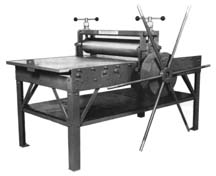 An
Intaglio printing press...
An
Intaglio printing press...
Inking and Printing the Intaglio Plate:
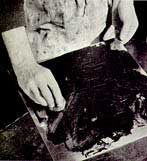 1) Inking the copper plate; pushing the ink into the grooves.
1) Inking the copper plate; pushing the ink into the grooves.
The clean plate is then spread with ink that is carbon based blended with linseed oil (finely ground so it is smooth and silky). The black ink ranges from a cool blue (plant based carbon) to a warm tone which is animal based. Inking is done on either a warm hot plate or at room temperature.
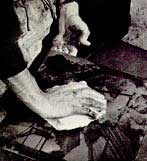 2) Wiping the plate with a piece of starchy cheesecloth called tartleton
2) Wiping the plate with a piece of starchy cheesecloth called tartleton
Once ink is spread onto the plate and the surface area wiped off, the beveled edges cleaned, then the plate is then ready for printing.
.  3) Further wiping of the plate with a piece of paper to pull up the whites.
3) Further wiping of the plate with a piece of paper to pull up the whites.
The fully inked metal plate is then placed on a large steel press bed on a piece of dry paper. Then a moist blotted piece of material, often rag or acid-free paper is placed over the plate.
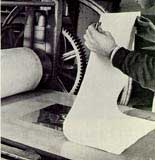 4) The plate is laid on the press bed, then the paper carefully laid on top.
4) The plate is laid on the press bed, then the paper carefully laid on top.
 5) The plate and paper is then covered with the felt blankets and then rolled through the press.
5) The plate and paper is then covered with the felt blankets and then rolled through the press.
Thin wool felt blankets of varying widths are then placed over the plate & paper, and the whole bed is fed and/or rolled through the Intaglio press, pushing the moist paper into the grooves, transferring the ink to the paper.
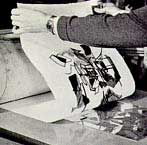 6) After the felt blankets are removed, the paper is lifted from the plate revealing a mirror image of the drawing on the plate. The printed image then appears in reverse on the moist paper, which is then lightly pressed or hung to dry.
6) After the felt blankets are removed, the paper is lifted from the plate revealing a mirror image of the drawing on the plate. The printed image then appears in reverse on the moist paper, which is then lightly pressed or hung to dry.
Most illustrations above are taken from the Donald Staff, Deli Sacilotto book entitled, "Printmaking"
You tube videos on Intaglio process and printing:
Printmaking Processes: Intaglio - Minneapolis Institute of Art - etching, drypoint and engraving
Pressure + Ink: Intaglio Process - The Museum of Modern Art
Printing etching 'Nigredo The Dark Side of Eden' - Anna Charaktinou (printing a large plate a la poupeé)
A la poupeé Printing
A single plate is selectively inked in different colors, using stumps of rag known as a “poupée.” This is one of the ways of getting colour into a print. This print was wiped a la poupée.
Created by Gisele Beaupre ©